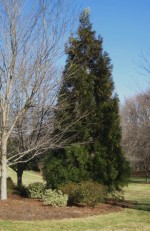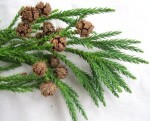 One of the outstanding conifers in my garden is Japanese cedar. There are many varieties, including dwarf forms, and each offers something special. For Christmas greens, you can’t beat var. sinensis and I carefully harvest the tips of the branches each year for inclusion in the many arrangements I make to decorate my house. As a tall screen along the property line it is a good alternative to Leyland cypress (although a bit wider), and also makes a good specimen tree or background for rhododendrons and azaleas because it tolerates shade. The dwarf forms vary in shape and color and are attractive inclusions in our rock garden.
One of the outstanding conifers in my garden is Japanese cedar. There are many varieties, including dwarf forms, and each offers something special. For Christmas greens, you can’t beat var. sinensis and I carefully harvest the tips of the branches each year for inclusion in the many arrangements I make to decorate my house. As a tall screen along the property line it is a good alternative to Leyland cypress (although a bit wider), and also makes a good specimen tree or background for rhododendrons and azaleas because it tolerates shade. The dwarf forms vary in shape and color and are attractive inclusions in our rock garden.
 Actually, Japanese cedar is not a cedar at all but is related to the redwoods, metasequoias, and giant sequoias. It is, however, Japanese and is the national tree of Japan where it is known as Sugi. The over all look of the tree is bushy and full but a close view reveals that the short prickly needles form a scale-like covering on the branches. The branches droop gracefully and screen the trunk from view, a pity because the reddish-brown bark of mature trees peels off in long shreds but can’t be seen and appreciated.
Actually, Japanese cedar is not a cedar at all but is related to the redwoods, metasequoias, and giant sequoias. It is, however, Japanese and is the national tree of Japan where it is known as Sugi. The over all look of the tree is bushy and full but a close view reveals that the short prickly needles form a scale-like covering on the branches. The branches droop gracefully and screen the trunk from view, a pity because the reddish-brown bark of mature trees peels off in long shreds but can’t be seen and appreciated.
Type: Evergreen tree.
Outstanding Feature: Dark green foliage; bushy texture.
Form: Pyramidal.
Growth Rate: Moderate-Rapid (some varieties slow).
Bloom: Small terminal cones, male and female cones are borne separately on the tips of branches..
Size: to 60’ H x 30’ W.
Light: Full sun to partial shade.
Soil: Fertile, moist, well-drained.
Fertilizer: Slow release fertilizer as needed.
Hardiness: Zones 6-9.
Care: Water during times of drought.
Pests and Diseases: Mites possible.
Propagation: Seed difficult; cuttings of mature tips in late summer or early fall; layering; grafting.
